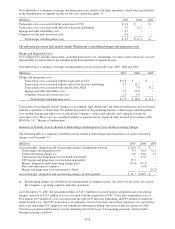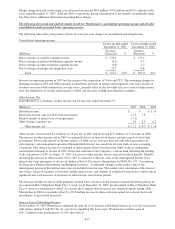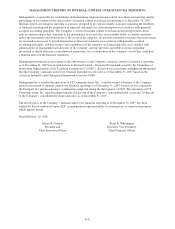Windstream 2007 Annual Report Download - page 110
Download and view the complete annual report
Please find page 110 of the 2007 Windstream annual report below. You can navigate through the pages in the report by either clicking on the pages listed below, or by using the keyword search tool below to find specific information within the annual report.
providing access to or usage of the Company’s networks and facilities. Due to varying customer billing cycle cut-off
times, the Company must estimate service revenues earned but not yet billed at the end of each reporting period. Sales
of communications products, including customer premise equipment and modems, are recognized when products are
delivered to and accepted by customers. Fees assessed to communications customers to activate service are not a
separate unit of accounting and are deferred upon activation and recognized as service revenue on a straight-line basis
over the expected life of the customer relationship in accordance with Emerging Issues Task Force (“EITF”) 00-21
“Revenue Arrangements with Multiple Deliverables”. The direct costs associated with activating such services, up to
the related amount of deferred revenue, are deferred and recognized as an operating expense over the same period.
The Company recognizes certain revenues pursuant to various cost recovery programs from state and federal Universal
Service Funds, and from revenue sharing arrangements with other local exchange carriers administered by the National
Exchange Carrier Association. Revenues are calculated based on the Company’s investment in its network and other
network operations and support costs. The Company has historically collected the revenues recognized through this
program, however, adjustments to estimated revenues in future periods are possible. These adjustments could be
necessitated by adverse regulatory developments with respect to these subsidies and revenue sharing arrangements,
changes in the allowable rates of return, the determination of recoverable costs, or decreases in the availability of funds
in the programs due to increased participation by other carriers.
Allowance for Doubtful Accounts – In evaluating the collectibility of our trade receivables, we assess a number of
factors, including a specific customer’s ability to meet its financial obligations to us, as well as general factors, such as
the length of time the receivables are past due and historical collection experience. Based on these assumptions, we
record an allowance for doubtful accounts to reduce the related receivables to the amount that we ultimately expect to
collect from customers. If circumstances related to specific customers change or economic conditions worsen such that
our past collection experience is no longer relevant, our estimate of the recoverability of our trade receivables could be
further reduced from the levels provided for in the consolidated financial statements.
Pension and Other Postretirement Benefits – The annual costs of providing pension and other postretirement benefits
are based on certain key actuarial assumptions, including the expected return on plan assets, discount rate and
healthcare cost trend rate. Windstream’s pension expense for 2008, estimated to be approximately $0.3 million, was
calculated based upon a number of actuarial assumptions, including an expected long-term rate of return on qualified
pension plan assets of 8.00 percent and a discount rate of 6.36 percent. In developing the expected long-term rate of
return assumption, Windstream evaluated historical investment performance, as well as input from its investment
advisors. Projected returns by such advisors were based on broad equity and bond indices. The Company also
considered the historical returns of the plan since 1975, including periods in which it was sponsored by Alltel, of 10.84
percent. The expected long-term rate of return on qualified pension plan assets is based on a targeted asset allocation of
50.0 percent to equities, with an expected long-term rate of return of 9.0 percent, 40.0 percent to fixed income assets,
with an expected long-term rate of return of 6.0 percent, and 10.0 percent to alternative investments, with an expected
long-term rate of return of 11.0 percent. For the year ended December 31, 2007, the actual return on qualified pension
plan assets was 6.83 percent. Lowering the expected long-term rate of return on the qualified pension plan assets by 50
basis points (from 8.00 percent to 7.50 percent) would result in an increase in our pension expense of approximately
$4.9 million in 2008.
The discount rate selected is based on a review of current market interest rates of high-quality, fixed-rate debt
securities adjusted to reflect the duration of expected future cash outflows for pension benefit payments. In developing
the discount rate assumption for 2008, Windstream reviewed the high-grade bond indices published by Moody’s and
Standard & Poor’s and other available market data as of December 31, 2007, and constructed a hypothetical portfolio
of high quality bonds with maturities that mirrored the expected payment stream of its pension benefit obligation. The
discount rate determined on this basis was 6.36 percent at December 31, 2007. Lowering the discount rate by 25 basis
points (from 6.36 percent to 6.11 percent) would result in an increase in our pension expense of approximately
$2.2 million in 2008.
On August 17, 2006, the Pension Protection Act of 2006 (the “Act”) was signed into law by Congress. In general, the
Act changed the rules governing the minimum contribution requirements for funding a qualified pension plan on an
annual basis without paying excise tax penalties. Among other requirements, the Act changed the assumptions used to
calculate the minimum lump-sum benefit payments, applied benefit restrictions to plans below certain funding levels,
and eliminated certain sunset provisions contained in the Economic Growth and Tax Relief Reconciliation Act of 2001
(“EGTRRA”). EGTRRA increased the maximum amount of benefits that a qualified defined benefit pension plan could
pay and increased the maximum compensation amount allowed for determining benefits for qualified pension plans.
Windstream is complying with the provisions of the Act. The qualified pension plan is funded greater than 110 percent
for the 2007 plan year and therefore does not expect to be subject to benefit restrictions in 2008. The assumptions
F-24
























